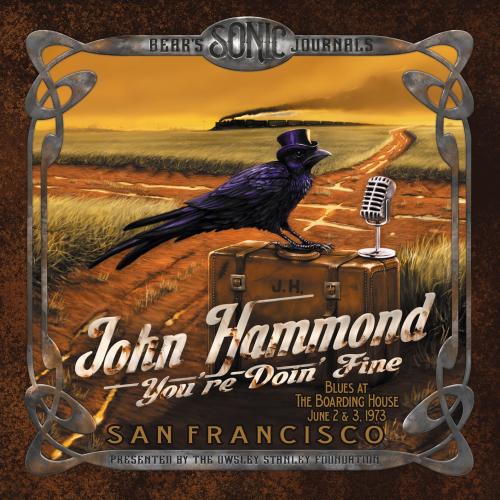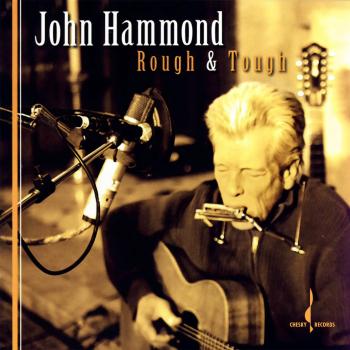
Bears Sonic Journals: You’re Doin’ Fine — Blues at the Boarding House, June 2 & 3, 1973 (Remastered) John Hammond
Album info
Album-Release:
2024
HRA-Release:
22.11.2024
Album including Album cover
- 1 Wang Dang Doodle (Live at the Boarding House, 6/2/1973) 04:35
- 2 Gambling Blues (Live at the Boarding House, 6/2/1973) 04:44
- 3 I Can't Be Satisfied (Live at the Boarding House, 6/2/1973) 06:12
- 4 Hitchhiking Woman (Live at the Boarding House, 6/2/1973) 06:46
- 5 Shake For Me (Live at the Boarding House, 6/2/1973) 04:24
- 6 Honeymoon Blues (Live at the Boarding House, 6/2/1973) 02:09
- 7 Rag Mama (Live at the Boarding House, 6/2/1973) 02:59
- 8 Sweet Home Chicago (Live at the Boarding House, 6/2/1973) 05:49
- 9 I Wish You Would (Live at the Boarding House, 6/2/1973) 04:00
- 10 King Bee (Live at the Boarding House, 6/2/1973) 05:25
- 11 Help Me (Live at the Boarding House, 6/2/1973) 04:16
- 12 Death Bells (Live at the Boarding House, 6/2/1973) 07:17
- 13 Honeymoon Blues (Version 2) (Live at the Boarding House, 6/2/1973) 03:39
- 14 You're So Fine (Live at the Boarding House, 6/2/1973) 04:58
- 15 Look On Yonder's Wall (Live at the Boarding House, 6/2/1973) 04:52
- 16 Traveling Riverside Blues (Live at the Boarding House, 6/2/1973) 08:47
- 17 Little Rain (Live at the Boarding House, 6/2/1973) 03:34
- 18 Truckin' Little Baby (Live at the Boarding House, 6/2/1973) 03:26
- 19 It's Too Late, She's Gone (Live at the Boarding House, 6/2/1973) 02:50
- 20 You Don't Love Me (Live at the Boarding House, 6/2/1973) 03:43
- 21 Ridin' In The Moonlight (Live at the Boarding House, 6/3/1973) 03:06
- 22 Malted Milk (Live at the Boarding House, 6/3/1973) 03:01
- 23 I Can't Be Satisfied (Live at the Boarding House, 6/3/1973) 05:29
- 24 It Hurts Me Too (Live at the Boarding House, 6/3/1973) 03:15
- 25 Boogie Chillen' (Live at the Boarding House, 6/3/1973) 04:26
- 26 She Moves Me (Live at the Boarding House, 6/3/1973) 02:40
- 27 Rag Mama (Live at the Boarding House, 6/3/1973) 01:30
- 28 Ask Me Nice (Live at the Boarding House, 6/3/1973) 03:48
- 29 Love Changing Blues (Live at the Boarding House, 6/3/1973) 05:20
- 30 Preachin' Blues (Live at the Boarding House, 6/3/1973) 04:35
- 31 Go On To School (Live at the Boarding House, 6/3/1973) 03:26
- 32 Ride 'Til I Die (Live at the Boarding House, 6/3/1973) 04:54
- 33 Drunken Hearted Man (Live at the Boarding House, 6/3/1973) 03:53
- 34 Look On Yonder's Wall (Live at the Boarding House, 6/3/1973) 05:34
- 35 Terraplane Blues (Live at the Boarding House, 6/3/1973) 05:27
- 36 No Money Down (Live at the Boarding House, 6/3/1973) 03:42
- 37 Truckin' Little Baby (Live at the Boarding House, 6/3/1973) 02:59
- 38 Ground Hog Blues (Live at the Boarding House, 6/3/1973) 04:40
- 39 Junco Partner (Live at the Boarding House, 6/3/1973) 03:52
- 40 I'm Leaving You (Live at the Boarding House, 6/3/1973) 02:58
- 41 From Four Until Late (Live at the Boarding House, 6/3/1973) 03:30
- 42 Traveling Riverside Blues (Live at the Boarding House, 6/3/1973) 05:33
- 43 Hitchhiking Woman (Live at the Boarding House, 6/3/1973) 05:06
- 44 Shake For Me (Live at the Boarding House, 6/3/1973) 04:43
- 45 It's Too Late, She's Gone (Live at the Boarding House, 6/3/1973) 03:34
Info for Bears Sonic Journals: You’re Doin’ Fine — Blues at the Boarding House, June 2 & 3, 1973 (Remastered)
In a career spanning more than 60 years, John Hammond played with just about everyone and seemed to influence everyone else. You’re Doin’ Fine showcases John Hammond in his prime playing solo country blues. This master class of the blues romps through Delta, Chicago, Texas, and Piedmont blues, including six Robert Johnson songs.
Legendary producer and blues enthusiast John Hammond curated this recording, which features a stellar lineup of blues musicians. The set was recorded by Owsley “Bear” Stanley, renowned for his exceptional sound engineering skills.
The collection showcases a range of blues styles, from traditional to contemporary, with performances by notable artists of the time. Unfortunately, the search results do not provide a comprehensive tracklisting for this specific release. However, it is likely to feature a mix of solo and group performances, with artists such as Muddy Waters, Howlin’ Wolf, and other blues legends.
This recording is significant not only for its exceptional sound quality but also for its historical importance. The Boarding House was a prominent music venue in San Francisco during the 1970s, hosting many notable acts, including the Grateful Dead. The presence of Bear Stanley as the recording engineer adds to the significance of this release, as he was known for his work with the Grateful Dead and other prominent rock and blues acts.
“Solo is like a black and white photograph as compared to a colored photograph with all the shade…Black and white can be more stark and real, and more powerful than color.” (John Hammond)
“As a true solo artist, John brings the power of a full blues band to the stage…His guitar, his voice, and his harp transport us into a world where there is only the blues.” (Jorma Kaukonen)
John Hammond
Digitally remastered
John Hammond
was responsible for discovering Benny Goodman, Count Basie, Billie Holiday, Robert Johnson, Bessie Smith, Bob Dylan, Aretha Franklin, Pete Seeger, and Bruce Springsteen, among others. As a producer, writer, critic, and board member of the NAACP, he was credited as a major force in integrating the music business. An early inductee into the Rock and Roll Hall of Fame, John Hammond was one of the most important figures in 20th century popular music.
Born in 1910, Hammond was the fifth child of a wealthy New York family. From an early age, he showed a great interest in music. At age four he began studying the piano, only to switch to the violin at age eight. In his early teens he explored Harlem—listening to radio and live performances of black musicians. In 1927 he heard Bessie Smith sing at the Alhambra Theater. It was the peak of her career, and the performance would remain an influence on Hammond the rest of his life.
The next year Hammond entered Yale University, where he studied the violin and later the viola. He made frequent trips into New York and wrote regularly for trade magazines. Though a serious musician, his greatest talent would be in listening to, not playing, music. Eventually he dropped out of school for a career in the music industry—visiting England and becoming the U.S. correspondent for MELODY MAKER. Returning to the states, Hammond self-funded the recording of pianist Garland Wilson. The songs sold thousands of copies and brought Hammond, at age twenty, his first success as a record producer.
On his twenty-first birthday, Hammond moved to Greenwich Village, where he engaged in the bohemian life and leftist subculture. Though privileged since birth, Hammond recognized the gross injustice of the time and began working for an integrated music world. He was the funder and DJ for one of the first regular live jazz programs, and wrote regularly about the racial divide. His main concern, however, was jazz, and throughout the 1930s he was responsible for both integrating the musicians and expanding the audience.
Among the earliest musicians to work with Hammond were Fletcher Henderson, Bessie Smith, and Benny Goodman. When they began working together, Goodman’s band was completely white, and with the help of Hammond and great musicians like Teddy Wilson and Lionel Hampton, the color barrier began to fade. It was around this time that Hammond saw a young Billie Holiday perform. She was seventeen and Hammond thought she was one of the greatest singers he had ever heard. He began to write about her, and to introduce her to other musicians, including Teddy Wilson and Benny Goodman. Towards the end of the 1930s, Hammond organized the “Spirituals to Swing” concert, which brought much black music into the white spotlight for the first time.
Soon after “Spirituals to Swing,” Hammond invested in the first integrated night club, Cafe Society. The 1940s, however, were a time of great personal distress during which he lost a son and was divorced. He spent much of his time in Europe concentrating on classical music. It was not until the late 1950s that he became active in the industry again. It was then that he found an eighteen year-old singer with gospel roots and a powerful voice. He said she was the greatest singer since Billie Holiday, and it wouldn’t be long before the rest of the world felt the same way about Aretha Franklin.
Working for Columbia records, Hammond found in the political singers of the 1950s and 1960s a vibrancy similar to that of the jazz musicians thirty years earlier. He signed Pete Seeger, and found a young folk singer among the crowds of Greenwich Village named Bob Dylan. His early recordings of Dylan included “Blowin’ in the Wind” and “A Hard Rain’s A-Gonna Fall.” Important for the simplicity of their production, they attest to Hammond’s versatile skill and ability to bring out the best in a wide range of talent. In 1975, Hammond retired from Columbia, though he continued to scout for talent for many years. By the time of his death in 1987, the popular music industry had grown to be a more integrated and politically responsible community, and much of this progress was due to the talent and commitment of John Hammond. (pbs.org)
This album contains no booklet.











